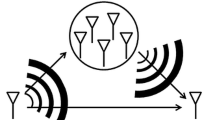Abstract
In this paper, we present the cooperative transmission distance with multiple decode-and-forward relays in a communication system. The investigation of the transmission distance is focused on how to achieve its maximum by minimizing the average symbol-error-ratio (SER) at the receiver. Firstly, we provide a closed-form formulation of the average SER in a multi-relay system, in which a signal is modulated and demodulated with M-quadrature amplitude modulation and is broadcast by the source and relays through narrow-band Rayleigh fading channels. Secondly, taking asymptotically tight approximation, we optimize the power allocation between the source and relays to minimize the SER. Thirdly, we provide a general expression of the transmission distance with the SER. Finally, we discuss the cooperative transmission distance with different parameters.






Similar content being viewed by others
References
Su, W., Sadek, A. K., & Liu, K. J. R. (2008). Cooperative communication protocols in wireless networks: Performance analysis and optimum power allocation. Wireless Personal Communications, 44(2), 181–217.
Aguilar, T., Syue, S.-J., Gauthier, V., Afifi, H., & Wang, C.-L. (2011). CoopGeo: A beaconless geographic cross-layer protocol for cooperative wireless ad hoc networks. IEEE Transactions on Wireless Communications, 10(8), 2554–2565.
Ding, Z., & Leung, K. K. (2011). Cross-layer routing using cooperative transmission in vehicular ad-hoc networks. IEEE Journal on Selected Areas in Communications, 29(3), 571–581.
Li, D. (2012). Outage probability and power allocation for cooperative multicast systems. IEEE Communications Letters, 16(7), 1080–1083.
Syue, S.-J., Wang, C.-L., Aguilar, T., Gauthier, V., & Afif, H. (2012). Cooperative geographic routing with radio coverage extension for SER-constrained wireless relay networks. IEEE Journal on Selected Areas in Communications, 30(2), 271–279.
Wang, Z., Chen, Y., & Li, C. (2012). CORMAN: A novel cooperative opportunistic routing scheme in mobile ad hoc networks. IEEE Journal on Selected Areas in Communications, 30(2), 289–296.
Lee, I.-H., Lee, H., & Choi, H.-H. (2013). Exact outage probability of relay selection in decode-and-forward based cooperative multicast systems. IEEE Communications Letters, 17(3), 483–486.
Wei, S., Goeckel, D. L., & Valenti, M. C. (2006). Asynchronous cooperative diversity. IEEE Transactions on Wireless Communications, 5(6), 1547–1557.
Assalini, A. (2009). Maximizing outage capacity of OFDM transmit diversity systems. IEEE Transactions on Vehicular Technology, 58(9), 4786–4794.
Dehghan, M., Ghaderi, M., & Goeckel, D. (2011). Minimum-energy cooperative routing in wireless networks with channel variations. IEEE Transactions on Wireless Communications, 10(11), 3813–3823.
Li, Q., Yan, Q., Teh, K. C., Li, K. H., & Hu, Y. (2013). A multi-relay-selection scheme with cyclic delay diversity. IEEE Communications Letters, 17(2), 349–352.
Salhab, A. M., Al-Qahtani, F., Zummo, S. A., & Alnuweiri, H. (2013). Outage analysis of \(N\)th-best DF relay systems in the presence of CCI over rayleigh fading channels. IEEE Communications Letters, 17(4), 697–700.
Brennan, D. G. (2003). Linear diversity combining techniques. Proceedings of the IEEE, 91(2), 331–356.
Li, F., Wu, K., & Lippman, A. (2006). Energy-efficient cooperative routing in multi-hop wireless ad hoc networks. In 2006 IEEE international performance computing and communications conference (pp. 215–222).
Zhao, H. V., & Su, W. (2010). Cooperative wireless multicast: Performance analysis and power/location optimization. IEEE Transactions on Wireless Communications, 9(6), 2088–2100.
Simon, M. K., & Alouini, M.-S. (1998). A unified approach to the performance analysis of digital communication over generalized fading channels. Proceedings of the IEEE, 86(9), 1860–1877.
Craig, J. W. (1991). A new, simple and exact result for calculating the probability of error for two-dimensional signal constellations. In Military communications conference, 1991 (MILCOM’91), conference record, military communications in a changing world (vol. 572, pp. 571–575), IEEE.
Author information
Authors and Affiliations
Corresponding author
Rights and permissions
About this article
Cite this article
Fang, M., Li, J. & Liu, K. Cooperative Transmission Distance in Multi-relay Communication Systems. Wireless Pers Commun 94, 1511–1522 (2017). https://doi.org/10.1007/s11277-016-3695-9
Published:
Issue Date:
DOI: https://doi.org/10.1007/s11277-016-3695-9




